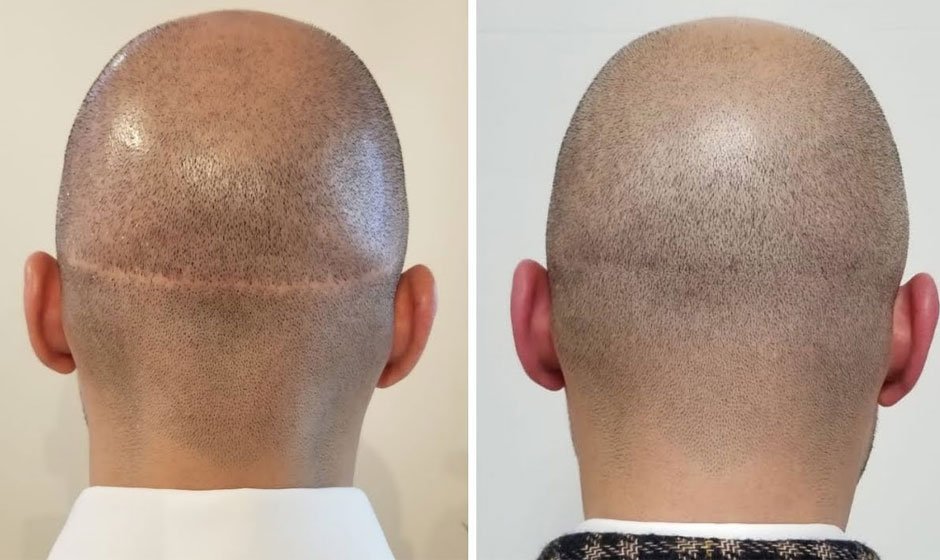Overview
Hair transplant surgery has evolved significantly, offering improved techniques compared to the early days of hair plugs. However, scarring remains an unavoidable consequence of the procedure. This article explores the types of scarring associated with hair transplant surgery, removal procedures, and options for concealing scars.
Procedures
There are two widely used surgical techniques for hair transplant: follicular unit extraction (FUE) and follicular unit transplantation (FUT). Each technique produces different types of scarring, and the surgeon’s skill plays a crucial role in minimizing scarring.
FUE (Follicular Unit Extraction)
FUE involves extracting hair follicles individually from the donor areas of the scalp. A micro-punch tool is used to remove each hair follicle graft, leaving tiny round scars approximately 1 millimeter in diameter. The extracted follicles, containing one to four hairs each, are then transplanted into recipient areas of the scalp. The procedure is performed on an outpatient basis under local anesthesia, without the need for stitches.
FUT (Follicular Unit Transplantation)
FUT involves surgically removing a strip of scalp with hair from the donor area, typically located at the back of the scalp. The area from which the strip is removed is then sutured together, leaving a linear scar of varying length. The hair follicle grafts are extracted from the strip and transplanted into recipient areas. Like FUE, FUT is performed as an outpatient procedure under local anesthesia. Stitches are typically removed after around 10 days.
Can Scars Be Removed?
While it is difficult to completely remove hair transplant scars, several procedures can help reduce their size or visibility. However, success is not guaranteed, and some scarring is likely to remain. Additionally, as the scalp naturally ages and sags over time, the scar may become more noticeable.
One potential option is grafting hair follicles into the scarred area using the FUE method. The viability of this approach depends on the thickness of the scar. Medication can also be used to thin scar tissue, increasing the potential effectiveness of grafting.
Concealing Scars
Another option for managing hair transplant scars is cosmetic concealment. Growing your hair longer over the donor area can help cover the scars. However, certain types of scars, such as keloid scars, may be more challenging to conceal. Keloid scars are raised scars that can grow larger than the original surgical scar and may continue to grow over time.
Alternative procedures can also aid in scar concealment:
Scalp Micropigmentation (SMP)
SMP, also known as medical hairline tattoo or scalp hair tattooing, involves injecting pigment into the scalp to create the illusion of thicker hair. This procedure can also be used to color in the scarred areas left behind by FUE or FUT. SMP may require multiple sessions and can cause some discomfort during the process.
Tricopigmentation (TMP)
TMP is a temporary form of SMP, where the ink is inserted into the top layer of the dermis. The duration of inking can vary from several months to a few years, depending on the clinic. Similar to SMP, TMP may cause physical discomfort for some individuals.
Laser Treatment
Laser treatment can help diminish the appearance of scars and is sometimes used in conjunction with SMP or TMP. The laser targets and removes damaged skin on the scar’s surface while stimulating collagen production in the dermis layer, improving the skin’s elasticity and overall appearance. Results may vary between individuals.
Takeaway
Hair transplant surgery offers a reliable solution for restoring hair, but scarring is an inherent part of the process. FUE tends to produce less noticeable scarring and may be preferable for certain individuals. Choosing an experienced surgeon is essential to minimize scarring. While complete scar removal is challenging, various procedures can help reduce the visibility of scars. Cosmetic concealment options, such as growing hair longer or utilizing scalp micropigmentation, offer additional alternatives. Discussing concerns and available options with a doctor can lead to informed decisions regarding hair transplant procedures. If scarring remains a significant concern, exploring alternative approaches like body hair transplant (BHT) may be worthwhile.









